After the collapse of the Quebec Bridge in August 1907, an Engineering Committee was formed under the supervision of the Transcontinental Railway Commission to undertake a complete redesign of the bridge. The Board consisted of one Canadian, H. E. Vautelet, one American, Ralph Modjeski, and one British Engineer, Maurice Fitzmaurice. Engineering News wrote of the Board,
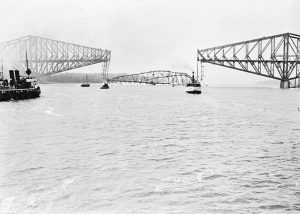
“The task of the engineering committee is a very great one. Difficult as it would be under any circumstances, the progress and results would be certain[ly] beyond question to engage the most careful attention of the engineering world. As matters actually stand, this attention will be multiplied by the stimulus of the intense interest awakened by the collapse of the first bridge. There will be a more anxious, more rigid scrutinizing of the conclusions and the designs produced by the committee. This fact renders their work correspondingly more delicate and of greater responsibility and therefore more difficult. Judgment of fine metal will be needed. May it not be corroded by the steam rising from the ever-boiling pot of Canadian politics! May the committee accomplish its task successfully and worthily.”
After a design competition, a contract was formally awarded on April 4, 1911, to the St. Lawrence Bridge Company consisting of the Dominion Bridge Company and the Canadian Bridge Company, with a clause placed in the contract stating,
“The contractor must satisfy himself as to the sufficiency and suitability of the design, plans, and specifications upon which the bridge is to be built, as the contractor will be required to guarantee the satisfactory erection and completion of the bridge, and it is expressly understood that he undertakes the entire responsibility, not only for the materials and construction of the bridge, but also for the design, calculations, plans, and specifications and for the sufficiency of the bridge for the loads therein specified. And the enforcement of any part or all of all parts of the specifications shall not, in any way, relieve the contractor from such responsibility.”
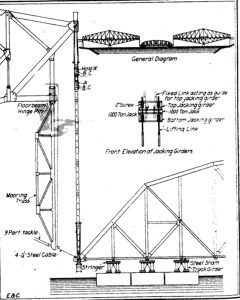
In other words, the contractor was solely responsible, even though they had to submit their plans and calculations to the Board for approval. Besides this and the previous bridge, the main difference is that the government now had a fully funded organization to oversee design and construction work. Nothing would be done until checked thoroughly by engineers from the Board and the Bridge Company. No assumption would be allowed to stand unless agreed to by both parties, and large-scale tests of members would be required if there was any question. The Board, in fact, made its own design independent of the design of the St. Lawrence Bridge Company and then compared its design with theirs. Any discrepancy was adjusted after a complete discussion. The Board tested quarter-size compression members at the Phoenix Iron Works to verify their designs. In addition, the Company decided to erect the anchor and cantilever arms in a similar manner to the original Phoenix Bridge plan but to erect the suspended span off-site, float it in, and lift it intact into place connecting with the ends of the two cantilever arms.
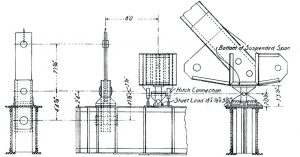
The anchor spans were 515 feet, the cantilever arms were 580 feet, and the suspended span was 650 feet. As the result of the thorough planning and checking of every detail of the design, the fabrication and erection work generally went smoothly. The field inspection staff for the government consisted of 33 men over the erection period. The bridge company had over 60 men working as engineers, draftsmen, calculators, and checkers on the job. The Dominion Bridge Company and the Canadian Bridge Company devoted their entire fabricating facilities to the bridge throughout its construction.
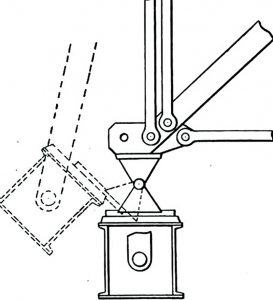
The suspended span was finished in July of 1916. The span weighed over 5,000 tons and was floated into place and connected to the lifting jacks on September 11. After a short lift, the span slipped off its supports and collapsed into the river. The official report of the Board of Engineers described, in part, the series of events on that fateful day as follows,
“Preparations for floating were completed about September 1st, 1916, but the range of tides, at this date, was not suitable…The next series of high tides occurred on September 11th, and, weather conditions being favourable, the span was floated at 3:40 am, and by 4:40 am, it was being towed out into the river…As the tide was running strong, the tugs had little to do but guide the span on its trip up the river. At 6:35 am, the span reached the bridge site, and at 7:40 am, the lifting hangers at all four corners had been connected. At 8:50 am, the jacks began lifting, and during the third lift of two feet, the scows floated clear, leaving the span suspended about 20 feet above the water…Up to this point, the entire operation of floating the span and connecting it to the lifting hangers had worked exactly according to schedule. Nothing occurred that had not been foreseen and provided for. There was no wind, and every condition was favourable. As the work remaining to be done was simply a repetition of mechanical operations which had already been successfully performed, it was felt that the most difficult part of the work had been satisfactorily accomplished.
At 10:30 am, jacking operations were resumed, and one more lift was made. The pins had been inserted connecting the lifting links to the fixed jacking girders, thus transferring the load directly to the cantilever trusses. The load on the jacks had been released, and they were being lowered for another lift when, at 10:50 am, a sharp report was heard, and the span was seen to slide off its end supports into the river.
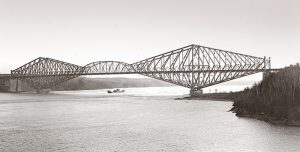
Unlike the first failure, where there were few eyewitnesses to the collapse, this time, the press, photographers, government officials, and the Board were on hand to witness it. Engineering News reported that “many prominent engineers from the United States and Canada were on the suspended span when the lifting operations began. At the intermission in the jacking operations, they came ashore. That saved their lives…”
Thirteen men were killed this time, with fourteen injured. Once again, an intensive investigation into the cause of the accident was launched. It was clear to all that the truss had fallen off of the southwest supporting girder, where the designers used cruciform steel castings at each corner to provide for rotation about two perpendicular axes.
Engineering News reported,
“A steel casting, by which the weight of the south upstream corner of the suspended span was transferred to the lifting girder, broke in such a manner that the girder kicked back from under it. This corner of the span dropped into the water, starting transversal rotation of the whole south end of the span… But experience teaches again that disaster may come, even to the most careful. In the light of what has happened at Quebec, engineers in every rank of the profession must realize anew that there is a lurking possibility of failure in every task that the engineer performs and that, when such failures come, those who suffer by it deserve the broad and generous sympathy of their brethren. The final success of any great engineering work depends on a multitude of details and on eternal vigilance to see that none are neglected. It is the engineer’s duty to study disasters to engineering works because of the useful lessons they may teach; but let him study them with all sympathy for his brother engineer who has borne the responsibility, remembering that he himself might have been in a like situation.”
The Engineering Record had similar thoughts, writing,
“Engineers, who must constantly face unknown factors in breaking new paths, will not lose faith in their brethren at Quebec, though the layman, seeing only the outstanding fact of a second serious loss at the site, may be a doubting Thomas…Fortunately, sufficient evidence was preserved on the girder to show exactly what happened. This evidence, combined with the detailed drawings, leaves it to every engineer to draw his own conclusions. Some will believe, as does this journal, that greater factors of safety should have been used in the intermediate castings and the suspension details.”
The Railroad Gazette wrote,
“From examinations of the hangers since the accident, it is evident that the intermediate or roller casting under the southwest hanger gave way. The fracture of the front lower pin bracket of this rocker threw the lower pin out of service, and the concentration of the 1,200-ton load on the remaining pieces crushed and tipped the remainder of the rocker at the same time kicking out the swinging girder and allowing the corner to fall. With the supports at this corner gone, the long, heavy span could not maintain its equilibrium, and it dropped into the river…The workingmen who were on the suspended span when it fell were thrown into the water. Of these, a number were saved by the small boats, but some 10 or 11 have not since been accounted for.”
On September 13, 1916, the St. Lawrence Bridge Company accepted full responsibility for the failure and took “immediate steps to replace the span.” The Board and the Bridge Company decided that the entire lifting apparatus would have to be rebuilt due to excessive deformations of the lifting links occasioned by the fall.
The investigating team submitted its report on October 19, 1916. The most significant finding was that the disaster was due solely to a failure of the casting.
Work on the new suspended span got underway on June 4, 1917, with the span being completed on August 27. It was floated into place on September 17, or just over one year after the failure. This time, the lift went as planned. The Engineer, London wrote, “one of the greatest, if not the greatest, feat of bridge engineering the world has ever seen was brought to a successful conclusion, on Thursday, September 20th, 1917 at 4:01 pm, when the 10-inch pins connecting the two sections of the Quebec Bridge to the ends of the cantilever arms were driven.”
As the engineering journals of the time wrote, “The final success of any great engineering work depends on a multitude of details and on eternal vigilance to see that none are neglected” and all engineers must “realize anew that there is a lurking possibility of failure in every task that the engineer performs.”■
